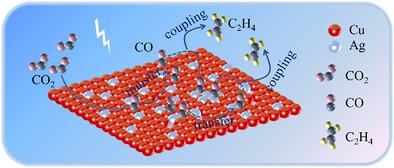Liquid-Liquid Interface -Driven Reconstruction of CuAg Nanocomposites for Selective CO2 to C2H4 Electroreduction
IF 12.1
2区 材料科学
Q1 CHEMISTRY, MULTIDISCIPLINARY
引用次数: 0
Abstract
The electrochemical CO2 reduction reaction (CO2RR) to multicarbon products such as C2H4 is critical for sustainable energy conversion but remains a significant challenge. Cu-based nanocatalysts can facilitate C─C coupling for C2+ product generation, yet their catalytic efficiency and selectivity require further improvement. In this study, a liquid-liquid interface etching strategy is employed, using Cu nanocubes as templates and aqueous AgNO3 as the etchant to synthesize well-defined CuAg nanocomposites. Among these, the optimized Cu67Ag33 composite nanocubes achieved a ethylene (C2H4) Faraday efficiency (FE) of 43.90% and a partial current density of 21.50 mA cm−2at −1.50 VRHE. This work demonstrates a versatile approach to integrate secondary metal active sites via directional confined etching, while reconstructing catalytic interfaces to enhance C─C coupling and C2H4 selectivity. These findings provide a strategic framework for the rational design of efficient CO2RR catalysts, advancing the development of sustainable carbon conversion technologies.

液-液界面驱动的CuAg纳米复合材料选择性CO2 - C2H4电还原重建
多碳产物如C2H4的电化学CO2还原反应(CO2RR)对可持续能源转换至关重要,但仍是一个重大挑战。cu基纳米催化剂可以促进C─C偶联生成C2+产物,但其催化效率和选择性有待进一步提高。在本研究中,采用液-液界面蚀刻策略,以Cu纳米立方体为模板,水溶液AgNO3为蚀刻剂,合成了定义良好的CuAg纳米复合材料。其中,优化后的Cu67Ag33复合纳米立方的乙烯(C2H4)法拉第效率(FE)为43.90%,分电流密度为21.50 mA cm−2at−1.50 VRHE。这项工作展示了一种通用的方法,通过定向受限蚀刻来整合二级金属活性位点,同时重建催化界面以增强C─C耦合和C2H4选择性。这些发现为合理设计高效的CO2RR催化剂提供了战略框架,推动了可持续碳转化技术的发展。
本文章由计算机程序翻译,如有差异,请以英文原文为准。
求助全文
约1分钟内获得全文
求助全文
来源期刊

Small
工程技术-材料科学:综合
CiteScore
17.70
自引率
3.80%
发文量
1830
审稿时长
2.1 months
期刊介绍:
Small serves as an exceptional platform for both experimental and theoretical studies in fundamental and applied interdisciplinary research at the nano- and microscale. The journal offers a compelling mix of peer-reviewed Research Articles, Reviews, Perspectives, and Comments.
With a remarkable 2022 Journal Impact Factor of 13.3 (Journal Citation Reports from Clarivate Analytics, 2023), Small remains among the top multidisciplinary journals, covering a wide range of topics at the interface of materials science, chemistry, physics, engineering, medicine, and biology.
Small's readership includes biochemists, biologists, biomedical scientists, chemists, engineers, information technologists, materials scientists, physicists, and theoreticians alike.
 求助内容:
求助内容: 应助结果提醒方式:
应助结果提醒方式:


